For Beijing, it's 3, 2, 1....blastoff!!!
While scientists and engineers across the country work overtime, in the hills outside the Chinese capital, 12 men are training to take the world's most populous nation on a giant leap into the Final Frontier. An inside look at China's space program.
By Ron Gluckman/Beijing,China
IN THE LEAFY COUNTRYSIDE NORTH OF BEIJING, high-voltage towers of Babylonian proportions rise out of the cornfields, marring the landscape at the foot of the Fragrant Hills.
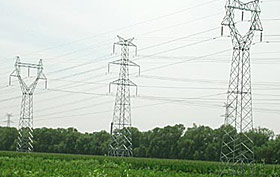 The
towers are new - some still undecorated by live wires - and numerous. Their
presence signals to the few who venture past that the land is marked for
progress.
The
towers are new - some still undecorated by live wires - and numerous. Their
presence signals to the few who venture past that the land is marked for
progress.
The transmission lines converge in the distance, giving away the location of Beijing Aerospace City, a tightly-guarded enclosure that is protected as much by the pastoral landscape as by the People's Liberation Army (PLA).
Military clearance is required to get inside. Perseverance and rare, often contradictory, information supplied by academics, diplomats, reporters and aerospace suppliers has brought me this far.
My interest in the place isn't casual. It reportedly houses a team of astronauts, the first in a generation, chosen to lead the nation on a new Great Leap Forward into space. If their mission is a success, China will become the third member of an exclusive club of space-faring nations. The launch that can put them there is perhaps months away.
Driving out of Beijing on the way to the foothills, the view is eclectic, typical of big cities in China these days: cranes and wrecking balls erase the detritus of Russian-inspired concrete worker units, while next door rise glass towers, monuments to the new mood of capitalism.
My companion and I travel for nearly an hour, mostly along a new, elevated six-lane highway. It is nearly empty. Down below lies the real China: coal-heated shacks still served by horse and donkey cart, medieval neighborhoods cemented in past centuries.
Sleek black Mercedes sedans carrying China's foremost aerospace experts travel the same route daily, but their windows are blackened so no one can see inside.
They are ferrying their important passengers towards Aerospace City and, ultimately, towards the cosmos.
Exiting the highway takes us into the farmland skirting the Fragrant Hills, an ironic location for classified research facilities, for it was once the home of the Emperor's Summer Palace.
Here, amongst fresh air and flowers, the entire Imperial Court journeyed to escape not only the heat of the capital, but also the political intrigue. At least until the city-sized estate of lakes, temples and pagodas was razed by foreign forces at the turn of the century in retaliation for Chinese killings during the Boxer Rebellion.
The rubble was long ago cleared away and a new summer palace built to serve the short remaining years of the Qing Dynasty. But now, the lush farmland and thick forests we find ourselves in is the preserve of the PLA, real rulers of today's People's Republic.
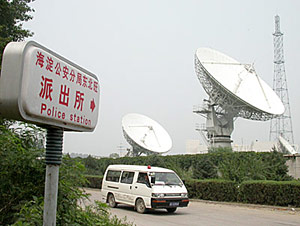 Stopping
for directions is dangerous, because soldiers tend crops when not on guard duty,
sometimes dressed in peasant clothes.
Stopping
for directions is dangerous, because soldiers tend crops when not on guard duty,
sometimes dressed in peasant clothes.
"Everything belongs to the military," says one field worker. "They have taken all the land, but no one knows what they plan to do with it." Looking around furtively as he tends his squatter crops, he adds: "It's all top secret."
The scene suggests enormous communication capabilities in a place that has passed from antiquity to modernity almost overnight.
Later, we hear from an overseas source who has followed China's space program since the beginning: "That sounds like the place I keep hearing about, the center of China's intelligence industry. It sounds like you're on the right track."
Now, following the transmission lines toward the horizon, we turn down rutted dirt roads, unmarked on any maps, and eventually find, towering over fields of corn and guava trees, enormous satellite dishes, six-stories high and big as apartment blocks.
Then, rounding a corner, we come to a clearing filled with a series of vast compounds, each bigger than a city block. All are fenced-off, with armed guards at the gate.
Amazingly, a nearby sign identifies it as Beijing Aerospace City. Is this the home of the elusive astronauts?
Exactly who these men are is unknown, although speculation runs rampant. Not a single picture of the astronauts has been printed. China National Space Administration (CSNA) officials vow to keep their identities secret until lift off.
Even privately, officials and academics involved with the program will say nothing about the nation's most talked about mystery men.
"None of us know anything about them," says Wen Lo Bong, a professor at Beijing Aerospace and Aeronautics University who insisted that his real name not be used, as did most sources. "We are all disciplined to say nothing."
Indeed, tracing the astronauts proves formidable. Officials refuse comment. Sources at universities are scared to even speculate and, if contacted at home, slam down phones. Clues come from printed reports that the astronauts live and train inside a red house within Beijing Aerospace City.
When excitement over China's space program soared to a crescendo last spring following the latest unmanned space flight, China Space News branded this training center "the Red Chamber."
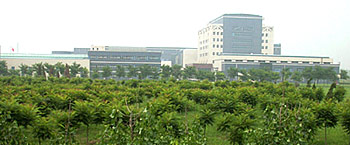 Behind
the fences at one compound, we spot huge cranes towering over 10-story buildings
with bright red roofs. Could this be the Red Chamber? There's no way to confirm
it onsite. The guards won't talk.
Behind
the fences at one compound, we spot huge cranes towering over 10-story buildings
with bright red roofs. Could this be the Red Chamber? There's no way to confirm
it onsite. The guards won't talk.
Circling around back, we snap pictures from the protective cover of bushes, then repeat the process at another enormous but isolated complex of blue and gray buildings nearby, China Airspace Research Center. Both are later identified as testing facilities for the space program.
One proves to be Mission Control. We haven't located the Red Chamber, but instead two components of China's space complex. Inside these labs and others scattered across China, Wen and his comrades are engaged in a raft of experiments and simulations that recall the 1960s Space Race. Only this time, they are all alone, racing the clock.
Although few will ever meet, all are partners in Project 921 - code name for an accelerated space program launched ten years ago this September.
Misleadingly ominous, the name results from the Chinese penchant for associating events with dates. Hence, the World Trade Center attack was dubbed Jiu-Yao-Yao (9-1-1).
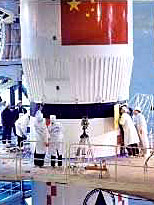 Project
921 was hatched September 21, 1992. A far more auspicious date, though, is on
the horizon. It may be in months, or perhaps years, but few space analysts
anywhere doubt that this day is coming - when China launches an aptly-named Long
March rocket, propelling into orbit a capsule containing a two-man crew, and
this ancient nation into space.
Project
921 was hatched September 21, 1992. A far more auspicious date, though, is on
the horizon. It may be in months, or perhaps years, but few space analysts
anywhere doubt that this day is coming - when China launches an aptly-named Long
March rocket, propelling into orbit a capsule containing a two-man crew, and
this ancient nation into space.
This has been a long-cherished dream for China, rendered all the more apparent a few days later when, back near the Fragrant Hills, we finally find the real Red Chamber, tucked deep inside a massive compound at China Beijing Space City.
On arrival, we realize it is part of the same group of fenced-in compounds we found before, but we failed to notice one in particular. Hidden behind trees deep inside, we see red.
Armed guards patrol the fences; one confirms, as do several passing workers, that this is indeed the astronaut's home, the Red Chamber.
The romantic name is an easy stretch - for
those who have never been here. There is a pale-red brick residential building
for the astronauts and their families, and a red and gray gymnasium alongside
where compound workers say the astronauts play basketball during breaks from
tests and training. The dominant structure, though, is a towering 20-story
administration building, looking like a cluster of rockets, colored steely gray.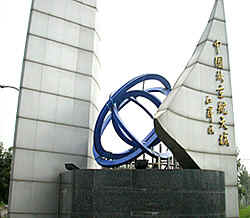
Research facilities are sprouting everywhere in Space City, where you can almost feel the farm land shudder under the cranes and scaffolding.
Although off-limits to non-workers, entry is via the welcoming You Yi Lu (Friendship Road) through a pair of abstract space sails on either side of the road, embossed with giant gold letters; the signature of President Jiang Zemin, who has made putting a man in space his pet project.
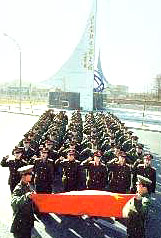 Yet
even here, donkey carts carry fresh-cut grass, and construction material is
hauled by China's unique three-wheeled vehicles, resembling a cross between a
tractor and a lawn mower. Posted signs warn: "Don't offend the soldiers
here."
Yet
even here, donkey carts carry fresh-cut grass, and construction material is
hauled by China's unique three-wheeled vehicles, resembling a cross between a
tractor and a lawn mower. Posted signs warn: "Don't offend the soldiers
here."
In dorm rooms behind a football field reside a dozen former fighter pilots, vying to be first for the flight of their lives. All are young, 30 years on average, and smaller and lighter than astronauts we've known in the past.
They typically stand about 1.7 meters (5.6 feet) high and weigh about 50 kg (110 pounds), according to Liu Zongying, chief designer of the capsule that will carry them, most likely two-at-a-time, into orbit.
Apollo crew members were about 60 per cent bigger, yet Liu rejects the "popular perception that they ought to be tall and strapping." In fact, the compact size of China's astronauts could prove an asset, he points out, since they will be crammed into a living space measuring a mere 2.8 by 2.25 meters.
Weekdays for the astronauts are spent in rigorous training that often extends through the night. "It's no fun club in there for the astronauts," one scientist confides. Even on rare visits outside the compound, they are guarded by special police.
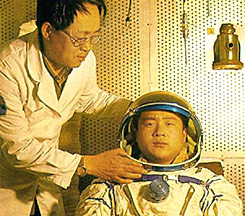 But
their health in space will depend on scientists who come not by chauffeured
sedans but by shuttle bus from Aerospace Medicine Project Institute, one of many
ivy-clad academic institutions in a ring around northern Beijing on Xue Yuan Lu
(University Road).
But
their health in space will depend on scientists who come not by chauffeured
sedans but by shuttle bus from Aerospace Medicine Project Institute, one of many
ivy-clad academic institutions in a ring around northern Beijing on Xue Yuan Lu
(University Road).
The second you slip past guards at the entrance, you realize this campus is unlike the others. Instructors, even research fellows, wear uniforms; the place is run by General Equipment Department, a division of the PLA.
Information is closely guarded. "You do realize that every call is recorded by our security department?" notes a clerk, before hanging up the phone.
A check of research is most revealing - aerospace medicine, gravitational physiology, space nutrition and other studies geared towards sustaining life in outer space. Yet the institution was set up in 1968, long before Project 921 - or any of its astronauts - was conceived.
Tracing the institution's history to the beginning illuminates some of the dark secrets about China's space program, and provides insight to the way science and politics occasionally collide in this communist country.
Space remained a largely unexplored territory until the fall of 1957, when the former Soviet Union launched Sputnik, the first orbiting satellite. America scrambled to send up satellites of its own, and the USSR upped the ante with manned flights.
That prompted American president John F. Kennedy to devote unlimited resources to beating the Russians to the moon. The race was on.
China's response was meeker. Chairman Mao reportedly asked, "How can we be considered a great power? China cannot even put a potato in space."
A decade after the end of its devastating civil war, and unrecognized by many nations, the Communist rulers of China were ill equipped to keep pace, although some Asian neighbors tried.
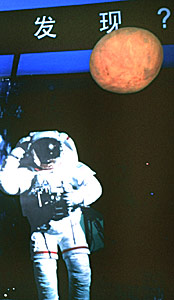 Japan
fired its first rocket in 1955, and India followed in 1963. China joined the
fray in the 1960s.
Japan
fired its first rocket in 1955, and India followed in 1963. China joined the
fray in the 1960s.
Early development centered on the Shuguang (Dawn) capsule, designed to carry a single man into space about three decades ago.
Research on a wide array of related concerns, including the feeding, housing and psychological impacts of humans in space was undertaken by the China Academy of Science's Institute of Biophysics and Military Work Physiology Research Institute.
Staff was enlarged and scientists put into uniform when the institutes merged 34 years ago to form Space Medicine Project Research Institute, moving to the present location on University Road. Work was steady.
Mao announced the launch of Project 714 in April 1971. Thousands of pilots were screened and within months, 19 astronauts were undergoing training.
Hampered by scarce resources and irregular funding, the program was ultimately derailed by political upheaval, an all-too common Chinese theme. A mysterious plane crash killed Mao's designated successor Lin Biao in the famous 913 Event (September 13, 1971).
Although Mao's protégé and comrade since the Long March days, Lin had lost favor with the Chairman, who became convinced that Lin was plotting a coup.
Despite their distance in a remote base and a lack of proof, the space scientists were implicated by association with Defense Minister Lin. Most were purged and many died in the terror of the Cultural Revolution, when all intellectuals were targeted.
Amazingly, amidst such turmoil, scientists in other facilities pressed on. In April 24, 1970, China blasted a satellite into space with the Dongfeng (East Wind) rocket. Five years later, China successfully launched its first recoverable satellite, a key component of any manned plans, since what goes up should be expected to come down safely.
Two more followed in 1976 and 1978, convincing observers that, despite the lack of funds and government support, China's space scientists might eke out a manned mission.
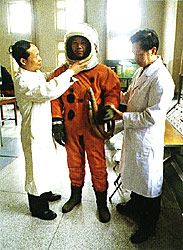 In
early 1980, pictures began circulating in Chinese media of astronauts bolted
into space suits, squeezing tubes of space food. Ships designed for recovery of
manned capsules were built and in the mid-1980s, following a sub-orbital launch,
one was successfully recovered in the South Pacific.
In
early 1980, pictures began circulating in Chinese media of astronauts bolted
into space suits, squeezing tubes of space food. Ships designed for recovery of
manned capsules were built and in the mid-1980s, following a sub-orbital launch,
one was successfully recovered in the South Pacific.
Then, with no explanation, the manned portion of the program was abandoned. Cost was the likely reason.
In the decades since, China has focused on commercial satellite launch, only recently refueling the manned program, which got a new lift recently with a series of successful launches of the Shenzhou craft.
Of course, they have had help, particularly with Project 921. In 1994 or 1995, Chinese officials went on a shopping spree in cash-starved Russia, returning with space suits, rocket engines and plans for a docking system.
Two Chinese astronauts went a year or two later for training at Yuri Gagarin cosmonaut center in Star City, Russia. There was a major stir when Chinese media named them as astronauts Wu Jie and Li Qinglong, but the pair are widely believed to be trainers rather than members of the current 12-man space team.
The Shenzhou spacecraft is modeled upon Russia's bell-shaped Soyuz, with a modified modular design that seems increasingly important to its future space plans. Like Soyuz, the Shenzhou includes a forward orbital module, re-entry capsule and aft-service module.
 There
is more space for scientific experiments thanks to a supplemental pallet in the
forward portion of the orbital module.
There
is more space for scientific experiments thanks to a supplemental pallet in the
forward portion of the orbital module.
More importantly, the orbital modules can be left in space where, equipped with independent propulsion and remote control, they can be used to practice docking and other maneuvers essential to manned flight.
The Shenzhou II module orbited for seven months. Shenzhou III's module is still circling the Earth, awaiting a possible rendezvous with Shenzhou IV, which should be launched later this year. Many speculate that these modules could be linked together in the future as a small but innovative Lego-like space shuttle.
Chinese officials, predictably, play up domestic design while discounting Russian elements. Officials and academics interviewed for this story invariably snapped at any mention of Russian help.
Perhaps understandable when one factors in the cost of what many deride as an enormous prestige-building program. Spending estimates range from $2-3 billion annually, a huge sum for any developing nation.
Public pride is clearly an important part of Project 921, yet space booster-ism can still reach absurd levels, even in a country renowned for flag waving.
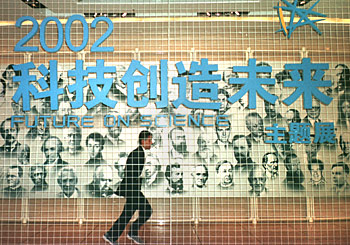 At
May's National Science and Technology Week exhibit in Beijing (May 2002), Wang
Zhuang and Zheng Songhui, chief designers of Shenzhou III, grew irked over
queries about the similarity of a capsule and space suit on display to Russian
gear.
At
May's National Science and Technology Week exhibit in Beijing (May 2002), Wang
Zhuang and Zheng Songhui, chief designers of Shenzhou III, grew irked over
queries about the similarity of a capsule and space suit on display to Russian
gear.
"Made In China!" Wang shouted, pointing to the capsule. Introducing some space food, Zheng repeated the phrase, but in English, as if directed at the foreign press. It made me recall a odd film screened in the Chinese capital a couple years ago.
"Heng Cong Chu Shi" told the true story of ill-equipped Chinese scientists who created the country's first atomic bomb in the Gobi desert during the height of the Cold War. One scene has always stuck with me.
When Russian scientists were recalled in the late 1950s because of the break in Russian-Chinese relations, the Chinese rummaged in rubbish bins, collecting scraps of paper with Russian formulas that they pasted together.
Afterwards, the audience all cheered. Nobody considered them cheats or copy artists. They were national heroes.
But times change, and no where more rapidly than in modern China. Big ring roads circle Beijing, where high-rises sprout daily from the rubble of ancient Hutongs, and massive shopping malls are anchored by the mandatory Starbucks. A decade ago, there was no coffee outside the few luxury hotels, and locals were excluded, since payment was only in Foreign Exchange Certificates.
Rapid growth has erased much of the old Chinese mystique, creating a cocky verve among the new generation, but also high expectations.
This new elite no longer celebrates China as a post-revolution new-born nation clawing its way up the ladder of world recognition. They want China to be seen as legitimate world power, and are desperately seeking signs of confirmation.
Hence, at the recent Beijing space exhibit, few paused for more than a glance at the hodgepodge of Chinese self-promotion, dog robots and dipole laser models, exhibited side-by-side with household electronics, all for sale.
A few years back, these would have drawn gaping crowds. But the main attraction in May was a large model of a rugged landscape dotted with bubble domes and derricks - Mars, as colonized by China.
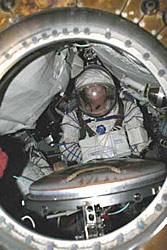 Chinese
officials were in peak cheerleading form, heralding their Long March on space in
terms that melded science with classic propaganda campaigns. Dates were extolled
not only for the first manned launch-within the next year-but also lunar
landings by 2010, and moon colonies and Mars missions within another 10 years.
Chinese
officials were in peak cheerleading form, heralding their Long March on space in
terms that melded science with classic propaganda campaigns. Dates were extolled
not only for the first manned launch-within the next year-but also lunar
landings by 2010, and moon colonies and Mars missions within another 10 years.
"China is expected to complete its first exploration of the moon in 2010, and will establish a base on the moon as we did in the South Pole and the North Pole," promised Ouyang Ziyuan.
With big, round glasses, and a kind, wrinkled face, the 67-year-old chief scientist of the program looks more like a good-natured grandfather than a bureaucrat. "Theoretically speaking," he insisted, "China is ready to explore the moon."
Qi Faren, chief designer of Shenzhou III, spoke poetically of a Chinese "shuttle-bus between Earth and the universe," linking an orbiting space station to celestial Chinese colonies.
Others spoke of mining-extraction schemes for the moon to service onward missions through the solar system as if the engineering were already proven and equipment earmarked in the next Communist Party 5-Year Plan.
Even now, members of the Chinese Science Academy will list, with perfectly straight faces, the metals to be used by off-world enterprises, state-run, of course.
Ouyang insists that space is still a race, at least from the point of view of the world's most populous nation, which has already depleted much of its forest and farmland.
"We need to find a new energy source to solve the energy crisis. The natural energy resources on the moon can satisfy the needs of humanity for thousands of years ahead."
This stark view of lunar-style Moonifest Destiny is commonplace in China - from generals on down to the general population. Perhaps that's to be expected from a people claiming numerous space firsts.
Chinese rocketry goes back 800 years and Wan Hu is credited with making man's first space flight in the sixteenth century, however briefly. Strapped to a chair studded with rockets, inventor Wan blasted off - into oblivion.
China's Long March to other planets began in earnest in late 1999 with the launch of the first Shenzhou, which successfully circled the globe 14 times.
President Jiang Zemin personally christened the craft; it means Heavenly or Divine Vessel, but also carries weight as an ancient name for China, meaning Powerful Country.
Shenzhou II followed in January 2001, carrying China's first space passengers - a monkey, dog and rabbit. They were aboard to test the life-support system but, after seven days in orbit, problems hampered the descent.
Chinese officials have never commented, but television coverage was abruptly cut and the lack of recovery photographs has fueled speculation that there was parachute failure and the animals did not survive impact.
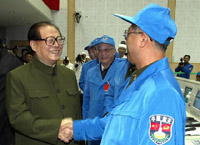 That
perhaps explains two changes with Shenzhou III, which launched in March without
biological specimens, and little television coverage - at least until successful
touchdown. Then, President Jiang appeared at Mission Control, pressing flesh
with workers at China's secret Jiaquan space facility in the Gobi desert.
That
perhaps explains two changes with Shenzhou III, which launched in March without
biological specimens, and little television coverage - at least until successful
touchdown. Then, President Jiang appeared at Mission Control, pressing flesh
with workers at China's secret Jiaquan space facility in the Gobi desert.
Off-screen, the astronauts were on hand, too, making their first tour of the control rooms and enormous launch pads that will soon propel them into history.
That's where they are bound, whatever the cost. But is it worth it? Many Chinese scientists wonder.
"There is nothing in this program, no breakthroughs," admits Wen, who says resentment is widespread among colleagues who cannot find research funding, while billions go to space. "Everything in this program was already done by the Russians in the 1950s."
Still, he concedes that to politicians, generals and the average Chinese, space simply seems the next logical rung in the climb to world greatness. But talk of space stations and shuttles, lunar landings and bases, even missions to Mars leave analysts amused.
"Pigs will fly," quips Craig Covault, senior editor of Aviation Week & Science Technology, who has followed China's space program since its start, "and cows will jump over the moon before the Chinese walk there."
Maybe so, but the captivating fact about China's space program, like others in the past, is that it dares the unknown. Such efforts inspire, not just national pride, but ideas and imagination.
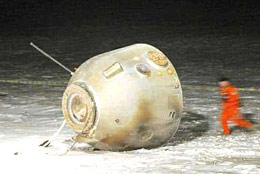 There
may no longer be a race for space, but what if this stirs a new one? Might these
flights not rekindle man's great hunger for space? "Nothing might inspire
the US as much as seeing a communist in orbit," concedes Covault.
There
may no longer be a race for space, but what if this stirs a new one? Might these
flights not rekindle man's great hunger for space? "Nothing might inspire
the US as much as seeing a communist in orbit," concedes Covault.
Back at the Red Chamber, seemingly worlds away from bustle of Beijing, the astronauts remain focused on their goal, sheltered from the skeptics, driven by ego and a nation's pride.
There are no sure bets, especially in space, as we tragically were reminded by the recent Shuttle disaster, but this one: the day is dawning.
Soon, special Chinese trains guarded by troops will haul scores of covered carriages from assembly plants across the country, to Jiaquan in remote north-west China, a perfect launch location.
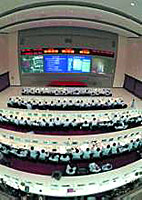 For hundreds of miles, there is nothing but
sand, and the last watchtower of the Great Wall, perhaps the grandest
architectural achievement of man, in nearby Jiayuguan.
For hundreds of miles, there is nothing but
sand, and the last watchtower of the Great Wall, perhaps the grandest
architectural achievement of man, in nearby Jiayuguan.
A thousand years ago, this was a Chinese outpost on the Silk Road, connecting the world's two great empires, Rome and China.
President Jiang watched the launch of Shenzhou III from this tower, and plans to reclaim his front-row seat sometime in 2003, for the latest lift-off. And he won't be alone.
Across China, people will be glued to TV screens for what, to them, isn't a one-man race, but another giant leap back to greatness.
Ron Gluckman is an American reporter who has been roaming around Asia since 1991, when he was based in Hong Kong. Since 2000, he has been based in Beijing, covering China for a wide variety of publications including Seed, which ran this large investigative feature in September 2002.
In the last days of that year, much as the article predicted, China launched Shenzhou IV, which circled the Earth 108 times in slightly under a week, touching down on January 5, 2003. Immediately thereafter, Chinese officials confirmed that the first manned flight would happen later that year.
As space watchers around the globe eagerly awaited the first new nation to put a man in space for half a century, across China, residents couldn't stop talking about the rocket. Not the space kind, but basketball player Yao Ming, with the NBA's Houston Rocket. Believe it or not, Beijing actually curtailed celebration of its own glorious entry into manned space exploration. As the launch approached in October 2003, Seed had me take another look at why China was smothering its own space program in secrecy.
Photo Credits, from top to bottom:
Pictures 1,2,3,5, 8 and 11, by Ron Gluckman. The rest from Chinese news wires or
space program sources. Note that the picture of the military flag ceremony is at
the same Space City that we infiltrated.
For another story on the China space program, see the piece published in the Asian Wall Street Journal, in its Weekend Edition May 31-June2, 2002.
To return to the opening page and index
push here
[right.htm]
